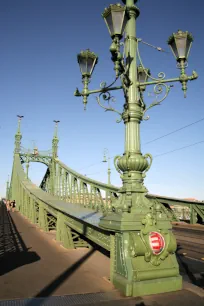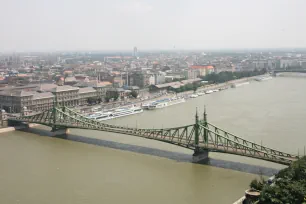The Freedom Bridge, often also called Liberty Bridge, was the third permanent bridge built in Budapest over the river Danube. The green painted iron bridge is one of the city’s most beautiful.

Inauguration


The bridge opened in 1896 as part of the country’s millennial celebrations. Emperor Franz Joseph, after whom the bridge was originally named, officially inaugurated the bridge by activating a device that hammered in the last nail, a silver one no less.
Design
The bridge derives its beauty from its graceful shape as well as the splendid decorations. The four tall spires are topped with statues of the legendary turul – a mythical bird – and a colorful crest is topped with a gilded crown. Parisian-style lampposts adorn the bridge on either side.
Reconstruction
During their retreat at the end of the Second World War, the German Army blew up all the bridges in Budapest, including this one. It was rebuilt shortly after the war according to the original plans, and all the ornaments were skillfully reconstructed. The bridge was given its current name when it reopened in 1946 on St. Stephen’s Day, Hungary’s most important national holiday.

